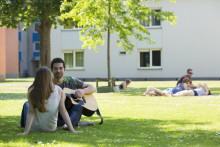If you have been paying attention to the Dutch news over the past couple of weeks, you may have heard of the arrival of Sinterklaas. Who is this character, and what does he mean for the Dutch?
Sinterklaas is the red-clad, white-horse-riding, miter-wearing, crosier-carrying bishop who comes from Spain at the beginning of winter with gifts for children. In accordance with tradition, he arrives on a steamboat with his many assistants, the Zwarte Pieten, on the Saturday three weeks before December 5.Each year he and his entourage officially land in a different town. On this day (in some circles all the days till the fifth), children place their shoes out in the hopes that their good behavior all year long and enthusiastic singing that evening will earn presents and treats. Typical treats are chocolate letters, pepernoten, marzipan, taaitaai and speculaas.
When set out, the shoes often contain a carrot or some hay for St. Nicholas's horse. On the evening of the 5th, Sinterklaas rides over the rooftops on his white horse, and children open the door to find a sack full of presents for the family. If you misbehave, you risk an empty shoe or worse: being spirited away to Spain in a sack. Gift giving on December 5th is not only for children; adults traditionally exchange gifts and write a poem that pokes fun at the recipient. Today there are even websites that will generate poems for you.
Sinterklaas is an amalgam of several legends, mainly the Christian bishop St. Nicholas with elements of Germanic gods (Wodan/Odin) in the mix. The historical St. Nicholas was a bishop from the ancient Lycian city of Myra in Asia Minor (present-day Turkey). Born in 280 A.D., persecution by the emperor Diocletian led the future saint to exile and imprisonment. He eventually attended the Council of Nicaea in 325 before he died on December 6 in 343 A.D. This day became a Christian feast day; some 200 years after his death, legends became popular about his character and good deeds, especially helping needy children. Through history St. Nicholas has been revered in many cultures. Very popular in the Middle Ages, he became the patron saint of children, mariners, orphans, laborers, travelers, merchants, judges, paupers, and marriageable maidens.
From Dutch immigrants, the American tradition of Santa Claus evolved from Sinterklaas and the legends of St. Nicholas. In A Knickerbocker's History of New York (1809), Washington Irving included many references to a Sinterklaas-type jolly Dutch burgher who gave gifts anonymously and came down chimneys.
The figure of Zwarte Piet (`Black Pete') has origins more difficult to trace. One story says he was an Ethiopian orphan slave who after gaining his freedom remained to serve the generous St. Nicholas. In the 17th and 18th centuries, it was fashionable for the European elite to have Moorish pages in their service. Today this is reflected in the costumes on the pieten. Another version maintains that the Zwarte Pieten are demons who have been forced by the Sint to do good works. And, when they escort Sinterklaas into town in November, the act of tossing candy to eager onlookers is a symbol of fertility. Also mentioned is a connection to chimneysweeps; one explanation is that after all these years bringing gifts down chimneys Piet is covered in soot and no one knows what color his skin really is.
How does this fourth-century bishop from Turkey come from Spain? One account holds that in May 1087, Italian admirers of the saint moved his bones from Myra to Bari in Italy to save Christian artifacts from the conquering Muslims, and that someone eventually confused one warm Mediterranean place for another. Why travel by steamboat? Many legends of the saint refer to his saving sailors at sea; as the patron saint of mariners many port cities have a church dedicated to Nicholas (in Holland: Amsterdam, Kampen, Harderwijk, Edam). Today, Sinterklaas and his pieten take advantage of the Netherlands' extensive canal system.
If you see a white-bearded man in a red miter, riding a white horse led by black-faced imps, then hurry home and put your shoe by the door.

Sinterklaas strides into Hengelo atop his white steed, led by Zwarte Pieten







